To search the RPR site click here
Just how did the artists create such excellent illustrations of Pitt-Rivers' second collection
There were two forms of illustration used by Pitt-Rivers after 1880. The first were the mostly line-drawings employed in his private publications such as his four volumes about the Excavations on Cranborne Chase. The other form of illustration was that employed in the catalogue of the second collection. In a letter in 1898 Pitt-Rivers makes clear the two techniques he wishes his draughtsmen to employ:
I think the best way will be for both the persons you name to send me specimens of their drawings of objects, such as antiquities of all sorts, both in pen & ink line drawings & black & white wash-drawing (mezzotints). My illustrations are done both ways and Mr Johnson * who has been with me 4 years and is still going to remain, can only illustrate in colours & mezzotints black & white, and not in line-drawing, so that I require to supply that want [L2076 S&SWM PR papers]
The training he required is discussed here.
All the volumes are illustrated to a degree. At first the drawings are outlines only, or rough drawings with some coloration, which must have been designed to be aide-memoires. In general the style of drawing is uniformly excellent (though different) from volume 3 onwards. This is when each artefact is given a separate illustration, usually a pencil outline with watercolour. Some effort is taken to represent the artefact 'in the round', to give it the appearance of shape and form, and three-dimensions. Care also seems to have been taken to get the colours as accurate as possible. Care is also taken to get proportions right, to produce scale-drawings (and the scale is often helpfully given alongside the illustration).
Relatively little is known about the creators of the illustrations in the nine volumes of the catalogue of Pitt-Rivers' second collection. It is clear that there were a number of creators as the artistic standards and skills vary from page to page, volume to volume. What is known about the artists is given here.
Flower and Peacock, the artists for part of the third volume, do not allow themselves as much space as do the later artists for each image, but their illustrations are often very aesthetically pleasing (at least, to the author). By volume four the pattern is set with only a maximum of five or six objects on each page, often just one or two and a lot of care taken over each image. By the end of the volumes the amount of text per artefact has dropped considerably and even vital information like what the object is, what its function was, where it was from or even from where it was acquired, and when, are missing. The images by the end are pre-eminent as information providers except for the last few pages where further items are listed in short, patchy, textual descriptions only.
Who were the artists?
See here.
Where were the artists when they prepared the illustrations?
The location of the studio or illustration room is unknown although it was in Rushmore, Pitt-Rivers' country estate.
It is clear that the light source was constant for most of volumes (which might imply that the room where the illustrations were made was also constant). The light source appears to be almost always from the right of the artist as he faced the artefact he was drawing, the light falling on the right hand side of the object. Very occasionally the light source appears to come from directly in front of the artefact. You can see an example here from page 831 (the first illustration on the page) where the light source is clearly from the right. This illustration is much more representative of the standard and coloration used in most of the illustrations after the very earliest, scrappiest, ones. Note that for part of volume 7, for some reason, the light falls from the left (I am grateful to Sue Johnson for pointing this out).
Sue Johnson has spent some time examining the detailed scans of the illustrations to see if there are further clues about methodology, lighting etc to be gleaned. We are very grateful to her for her support.
How were the illustrations prepared?
Certain conclusion can be drawn from the illustrations themselves about both the skill levels of the various artist illustrators and also the conditions in which they worked. Thompson and Renfrew speculate that 'the objects must first have been drawn in pencil, occasionally ink, with a general wash of the appropriate colour applied, and then touched up to represent corrosion, damage and so on. It was a laborious process that must have required much practice.' [1999: 9]
There are several examples which provide confirmation of this underdrawing, see for example an early example by Charles Flower from volume 3 [Add.9455vol3_p832] and another might be provided by page 2159 of volume 7 where there are several drawings of Indian figures in ?pen only (one is shown here).
There is an intriguing suggestion of how the artists might have created such accurate drawings, in L1978 in the Salisbury and South Wiltshire Museum's Pitt-Rivers papers, the writer asks, 'For this [preparing an accurate drawing] I need some machine which will aid to draw the profiles accurately, and I venture to ask you if the camera lucida, which I believe you use, would be likely to suit & (if so) if you could give me any hints about it.'
Sue Johnson, who has examined many of the images in the catalogue very closely writes:
... it makes total sense to me that the PR artists, at least some of them, might have been using a camera lucida. It is often used even now in scientific illustration, if only to get down the main lines (contour, the way a pattern wraps around a form, etc.). As I have worked with PR catalogue images I have been very aware that the paintings are HIGHLY accurate when it comes to creating the illusion of volume with complicated patterns. Noting that these paintings are often on a very small scale, the rendering of these patterns and illusion of volume has struck me as very skilled observational drawing BUT now with the possibility that a camera lucida might have been used – it makes much more sense. It also explains why there are not many “searching” lines in the renderings themselves; the outlines are instead quite assured – almost like the main lines had been traced. And, the highlights on some of these complicated objects also make more sense with the use of some sort of optical device. The other thing I would note is that I remember that some of the artists employed did not have much training and that by using a camera lucida they could have gained the needed skills quite rapidly. [Sue Johnson: pers comm.]
There has been no confirmation that a camera lucida was used, but it certainly seems a strong possibility.
Different techniques - the use of photography
There are several examples of photographs being over-painted in the catalogues, from page 1120 on, starting in May 1895 shortly after G.F. Waldo Johnson took over the preparing the entries and illustrations. Add.9455vol3_p1120 /1 for example shows a canoe prow which for the purposes of being photographed has been placed on a plinth in front of a sheet. It is not known whether the photograph was taken at Rushmore or Farnham Museum or from the dealer's original catalogue (Eva Cutter). Add.9455vol3_p1122 shows a photograph of a North American Plains coat similarly over-painted, having been pinned up on a back-curtain.
Many of the different styles of drawing / painting are incidentally shown in the mystery objects section.
How long did the drawings take?
An idea of how long it took to draw the more detailed drawings from part way through volume 3 is given by a note on page 2183 of volume 8 [shown here in an illustration]. This suggests it took 5 days to complete about 24 drawings or a strike-rate of just under 5 drawings a day which I think gives a fair idea of how much time was taken to render the objects accurately and also over the colouration. We do not know why this note was made, was someone (perhaps Pitt-Rivers?) querying the amount of time that was being taken over each drawing? The note was made at a time (1899 or 1900) when it was clear from the last three volumes (7-9) that a huge backlog of artefacts had grown up, in this volume items are catalogued from a mixture of years from 1896 to 1899 in a rather random order. We do not know either whether this strike-rate was considered 'normal' or 'acceptable' or even whether it was about the same rate as all the artists had achieved. However, assuming it was, then I estimate it would have taken roughly 136 working days for volume 4, 237 days for volume 5, 139 days for volume 6, 135 for volume 7, 166 days for volume 8 and 66 days at most to complete the small number of drawings in volume 9.
It is clear that by 1897 there was a time-lag between an artefact being acquired and it being illustrated. Indeed it is clear that the last three volumes were all, in effect, produced retrospectively, not only because of the note discussed above but because things are no longer listed in consistent date order and also types of artefact (ethnographic or archaeological; types like glassware; certain objects made from one material, like iron) are drawn together as though the undrawn artefacts were stored in a room until they were illustrated and moved to the Museum or other rooms in Rushmore. When the backlog had to be cleared it is possible that the artists (or Pitt-Rivers) preferred to retrieve objects by type and deal with them systematically.
How accurate are the drawings?
Sometimes comments are made about the standards of the drawing or how much they resemble the artefact itself. These are presumably made by later museum staff who were trying to find the artefacts depicted in the catalogues or trying to match found artefacts against the illustrations. Some examples of these comments are provided here. Obviously the exact working methods of the assistants is not known and it is clear that great attempts were made to render the objects accurately, for example from the middle volumes an attempt to measure the scale is made with items being annotated '1/2' (one half actual size, presumably) etc. As the artists were also producing site plans etc to scale for the archaeological excavations, one would presume that they brought some of that methodology (and technology) to the task.
One intriguing thing is that, late in the series around 1899, it is clear that Pitt-Rivers did inspect the volumes, see illustration of his signing the book to witness his approval, presumably of the accuracy of the drawings. There are only three incidences of this being noted, the handwriting is shaky in all instances, it may be that by this date the books had to be taken to Pitt-Rivers to be inspected as he was ill? All the notes are dated the same, February 5 1900, a matter of weeks before his death. The second is on page 2158 of volume 8 and the third page 2301 of volume 9. [Note: for pedants, Pitt Rivers does not hyphenate his name in these instances]
Many of the drawings, after the first book, appear to be very accurate indeed in so far as they present a very 'life-like' appearance. See here for more discussion of this topic.
AP, April - June 2010, tinkered with December 2010, link to wikipedia entry and more tinkering in June-July 2011.
* G.F. Waldo Johnson who remained until after Pitt-Rivers' death

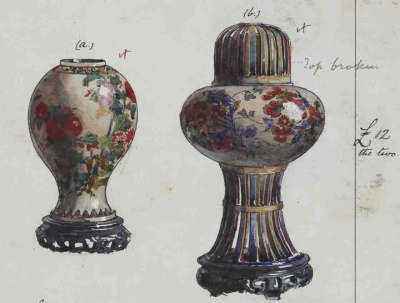
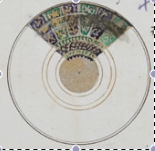
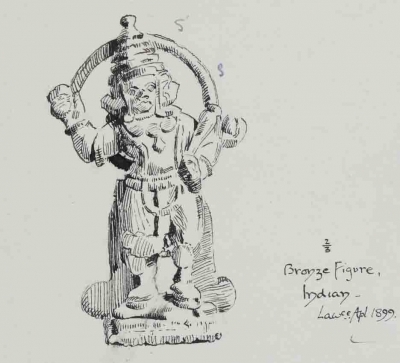
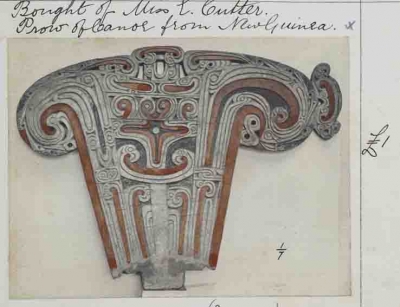
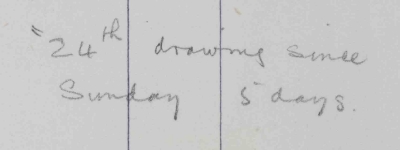
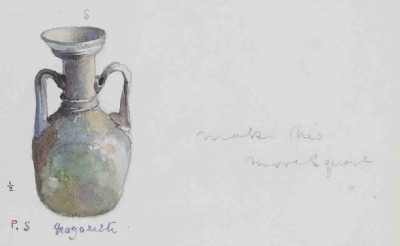
![Seen and approved? [Add.9455vol7_p2093 /2]](../../component/joomgallery/seen_approved_20100322_1695949185-view=image&format=raw&type=img&id=281&Itemid=41.jpg)


